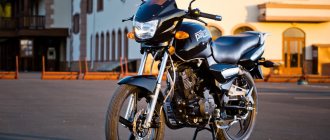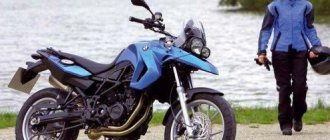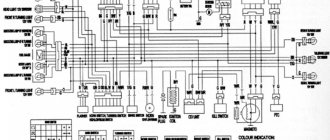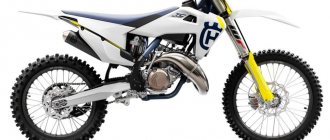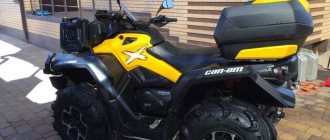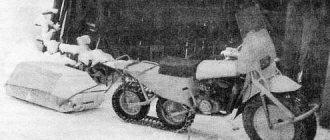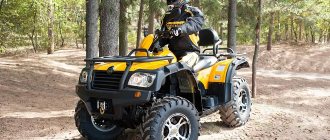Despite the reliability of the ATV, the driver is not immune from road accidents. The rider faces falls, collisions and many other troubles. But more than 70% of accidents can be avoided by following safety precautions, performing regular maintenance and monitoring the pressure in the ATV tires. Wheels affect not only ride comfort, but also the likelihood of accidents. For example, a vehicle with overinflated tires will jump over rough terrain like a mountain goat.
ATV tire pressure affects:
- Controllability of equipment. Properly inflated wheels will improve maneuverability and increase the sensitivity of the machine.
- Surface grip. The pressure in the ATV tires should depend on the load, season and route.
- Wheel balancing.
- Tread condition.
The pressure in the wheels affects the safety of the driver, so you should not neglect even such a small parameter.
What should be the pressure in ATV tires?
Fans of driving should pay attention to the fact that motorcycles are increasingly appearing in accident reports. Therefore, it is worth taking safety standards and the technical condition of vehicles more seriously, for example, regularly measuring the pressure in the ATV tires. In addition, this parameter determines the correct balancing of the vehicle, road grip, normal handling and tread integrity. An ATV is an off-road vehicle, and the normal condition of the wheels ensures its performance when moving over rough terrain. Consequently, only optimally selected and properly pumped tires will allow you to enjoy a fast and safe ride.
Optimal pressure
First, you need to refer to the vehicle’s operating instructions: as a rule, it describes the optimal pressure for a particular model, as well as restrictions. If there is no such information in the accompanying documentation, then it is worth using an average indicator, which is calculated based on the characteristics of the surface on which the equipment will be used. So, for example, when driving on rough terrain with soft soil (loose earth, sand or other loose rock), it is best to reduce the pressure to about 0.2-0.4 atmospheres: this will increase the area of contact of the tires with the surface. But at the same time, with low tire pressures, it is not recommended to increase the speed much, because then the ATV will be less responsive to the rider.
On smooth roads, for example, asphalt, the pressure in the ATV tires can be increased from 0.5 to 1 atmosphere, and then the vehicle will accelerate faster and be controlled better. Also, to increase comfort, the rear tires should be inflated a little more than the front tires. At a pressure above 1.5 atm. depreciation will decrease, which will affect ride comfort, as well as reduce traction and increase the risk of an accident.
Source
Strategy for choosing tires for motorcycles
What should you consider first when choosing ATV tires? Of course, the tread pattern, which determines traction and stability of the car both on a straight road and on turns. If you purchase used tires, you should take into account the degree of wear on both the rubber and the terrain. Incorrectly selected products reduce vehicle maneuverability and power. You need to know that ATV tires have a bias-ply design and not a radial design like a regular vehicle. These products are made from several layers of cords laid perpendicular to each other. ATV tires should have low pressure to protect off-road vehicles.
Are the tires chosen correctly?
According to domestic legislation, the quad must be equipped with tires, the use of which on public roads is not prohibited. How can this be understood? A very important element is the marking in the form of the letter E. It indicates that the product has passed European certification. In addition to the indicated letter, it must also have a number. It indicates the country within whose borders the certification was carried out. For example, 11 is England. If there is no approval number, then the E marking is invalid.
We would also like to remind you that the presence of the NHS marking on a tire means that it is designed for off-road use and is therefore not suitable for high-speed travel. Of course, owners of NHS tires are prohibited from driving on public roads.
Contact area between motor vehicle and ground
The pressure in an ATV tire provides such an important indicator as the “contact patch”. The normal indicator determines the optimal size. For example, if the pressure is low, then the “contact patch” is large, which means that the tread will quickly deform, grip on the road weakens, the motorcycle begins to “walk”, does not “hold” the terrain well and does not listen to the driver. If the indicator is high, that is, the tube is overinflated, then the contact between the ATV and the ground is reduced, the level of flexibility of the tire sidewall decreases, and depreciation is significantly reduced. Only optimally inflated tires provide high maneuverability, good speed, stable stability, necessary shock absorption and driving safety.
Model range and approximate cost
The AVM company released not just one Apache model, but as many as 7 models, not counting the Apache 150.
They all have the same prefix Apache, but differ mainly in numbers:
- AVM Apache 200;
- ABM Apache 400;
- Apache 150 basic;
- Apache basic 150cc;
- Apache Track 180cc;
- Apache Track 250 snowmobile;
- Apache 300.
Each model differs in price, characteristics, components and much more. However, the Apache 150 model is the main one, so most of the models in the above range are somewhat similar to the main model.
Each model differs in price and characteristics
AVM Apache 200 cc
The AVM Apache 200 ATV costs on average about 150 thousand rubles, provided that it has just rolled off the production line. If we talk about buying an ATV secondhand, its price is about 80 thousand rubles. Apache 200 is available in several color schemes. Blue and black colors are especially common.
ABM Apache 400 ATV
The AVM Apache 400 ATV is much more powerful than its counterpart, the Apache 150. For example, the first one can accelerate to 85 km/h. In other respects, the ABM Apache 400 ATV is also more powerful than most of its analogues. However, its price is appropriate. So, on average it costs about 290 thousand rubles.
Apache 150 basic quad bike
The Apache 150 basic ATV costs a little lower than its brother, the Apache 150, and has good reviews. This is due to the fact that this model is equipped somewhat worse, and is inferior in power. Because of this, the price of this ATV is about 115 thousand rubles.
AVM Apache basic 150cc
The AVM Apache basic 150cc ATV is extremely similar to the previous model. Their difference is not very significant. Thus, the cost of an abm apache 150cc quad bike is about 120 thousand rubles.
APACHE TRACK 180 cc
This device can be either an ATV or a snowmobile. This allows it to be used all year round. A very good model for outdoor enthusiasts. And the price is not very high. An ABM Apache 180 ATV costs approximately 160 thousand rubles on the Russian market.
Snowmobile Apache Track 250
The Apache Track 250 ATV-snowmobile is a more powerful unit than the previous model. One of the main advantages is the quick transformation from an ATV to a snowmobile and vice versa. However, the price has not increased much. So, it can be purchased for 180 thousand rubles.
Apache 300
The price of the AVM Apache 300 ATV varies the most on the market in Russia. For example, in one region you can buy it for 200 thousand rubles, and in another, exactly the same motorcycle equipment for 260 thousand rubles.
Features of movement on various routes
Whatever road you choose for riding motorcycles, before leaving the road you need to check the pressure in the ATV tires. When choosing a trip, you need to understand that when moving on different types of surfaces, different indicators in the cameras are needed. Soils can be hard: concrete, asphalt or compact soil. The road can be softer and more mobile: off-road, sand or snow. What pressure in the ATV tires must be provided in both cases? When driving off-road, values from 0.35 to 0.83 bar are recommended. If you have to travel on a hard road, it is better to increase the pressure from the nominal value by 25-40%. In the first case, some drivers recommend pumping up the rear wheels a little more.
dimensions
One of the main factors for the future owner of a motorcycle is the dimensions of the vehicle. After all, the more compact the model, the easier it is to place it in the garage or ride in narrow alleys. Apache 150 is medium in size.
The Apache 150 ATV has large wheels.
In more detail:
- during operation:
- length - 1740 mm;
- width - 980 mm;
- height is 1170 mm;
- during transportation:
- length - 1500 mm;
- width - 820 mm;
- height - 930 mm;
- wheelbase length is 1350 mm;
- the lowest ground clearance is 210 mm;
- the smallest turning radius is 3000 mm.
In general, for an ATV these dimensions are average. Considering its size, it is quite powerful, which is extremely rare for such motorcycles.
This all-terrain vehicle can be used in almost any area
Tire pressure CFmoto
One of the most popular ATVs is the CFmoto. It is often used in various test drives to determine the optimal parameters of certain indicators. That is, at the start, the pressure in the tires of the CFmoto ATV is set according to the standards, and then it is changed along the route and measurements are taken. Indicators from 1.1 to 1.5 bar turned out to be optimal for moving on asphalt, both for better maneuverability and for tire wear. Reduced rolling resistance on the road. But in off-road areas, encounters with unevenness were felt much harsher. In general, the pilots concluded that if most of the route is on a dense surface, it is better to maintain high pressure in the chambers.
Source
Model advantage
The Apache 150 ATV has large wheels and a fairly high suspension. It is these qualities that give this vehicle good maneuverability and maneuverability in almost any terrain, be it a bumpy field, snow, sand, swamp or forest.
You can use this all-terrain vehicle in almost any area of your life. For example, during active recreation or to perform some kind of work. Most often, hunters and fishermen have their eyes on this model.
In addition, the Apache 150 ATV is one of the cheapest of the Apache series.
Suitable tire pressure
When preparing the car for an upcoming trip, it is necessary to check its technical condition and the level of pressure in the wheels. A suitable indicator is selected taking into account the type of route. So:
- 0.2-0.4 atmospheres. To improve contact with surface types such as sand, clay, mud, etc., slightly inflated tires are suitable. But if you do not use them for driving on soft roads, then the service life of the tires is quickly reduced.
- 0.5-0.9 atmospheres. For good contact with a hard base (asphalt, gravel, etc.), tires with increased pressure are used. Such tires increase the stability of the ATV and allow it to corner more smoothly and gain high speed better.
- 1.5-2 atmospheres. Tires with this indicator are considered overinflated. They worsen the maneuverability and stability of the ATV, reduce depreciation, which leads to an increased risk of accidents.
Typically, the documentation for the equipment indicates the optimal tire pressure. This value is individual and is determined by the specifics of the model and its parameters. The season of operation of the model and the type of ground on which it will ride also affect the level of pressure in the wheels. If you plan to move on asphalt, then this figure should be 1.1-1.5 bar. It is believed that this will have a good effect on handling and will also reduce tire wear, for example 22*10.00-10. For soft surfaces, 14 psi is considered optimal. In any case, it is important to adhere to this rule - the rear wheels should have a little more pressure than the front ones in order to increase maneuverability and ride comfort.
Source
Other options
Other parameters include secondary qualities of the ATV or those that cannot be classified into one large group:
- The fuel tank volume is 7.5 liters;
- the weight of the entire Apache 150 ATV is 137 kg;
- it can be accelerated to a maximum of 65 km/h;
- maximum load capacity – 280 kg;
- number of seats – 1.5;
- at a speed of 20 km/h, the ATV will consume almost 4 liters of fuel for every 100 km.
As you can see, according to these parameters, the ATV also belongs to the average ATV. This also confirms other technical characteristics.
Air forced cooling system installed on transport
ATV tire pressure and tire selection
Despite the reliability of the ATV, the driver is not immune from road accidents. The rider faces falls, collisions and many other troubles. But more than 70% of accidents can be avoided by following safety precautions, performing regular maintenance and monitoring the pressure in the ATV tires. Wheels affect not only ride comfort, but also the likelihood of accidents. For example, a vehicle with overinflated tires will jump over rough terrain like a mountain goat.
ATV tire pressure affects:
- Controllability of equipment. Properly inflated wheels will improve maneuverability and increase the sensitivity of the machine.
- Surface grip. The pressure in the ATV tires should depend on the load, season and route.
- Wheel balancing.
- Tread condition.
Manufacturer and quality guarantee
specializes in the production of various motor vehicles. It began in 1996. It was in this year that the company opened and began producing motorcycles. At the moment, the plant’s products cannot be called original, because they buy some parts from their partners in China. However, despite this, the quality of the produced models still remains at a high level.
Specializes in the production of various motor vehicles
How is the pressure in an ATV tire related to the surface?
Before each trip, it is recommended not only to inspect the equipment, but also to check the pressure in the wheels. For each type of route, suitable indicators should be selected.
- 0.2-0.4 atmospheres. These indicators are suitable for driving on soft roads: sand, loose soil, clay, mud, wetlands, etc. Lightly inflated tires improve contact with the surface. But this recommendation also has a downside - a reduction in the “life” of tires.
- 0.5-0.9 atmospheres. By increasing the performance, the stability of the device on hard surfaces increases: asphalt, concrete, gravel, primer, etc. The car begins to corner more smoothly, reaches top speed faster and accelerates better.
- 1.5-2 atmospheres. Overinflated wheels impair the maneuverability and stability of equipment, reduce depreciation and increase the likelihood of an accident.
The documentation should indicate the optimal pressure in the ATV tires to ensure a comfortable ride. These indicators are individual and depend on the purpose of the device, season, weight and other technical parameters. For example, for comfortable driving on asphalt, the tire pressure of the CFmoto X8 ATV should be 1.1-1.5 bar. Surprisingly, such high performance has a beneficial effect on the vehicle’s handling and reduces tire wear.
If the manufacturer's recommendations are not included in the documentation, general standards should be followed. The optimal value for driving on soft surfaces is 0.35-0.83 bar. For travel on hard roads, it should be increased by 25-40%.
Note: The rear wheels should be inflated slightly more than the front wheels. This will improve ride comfort and increase maneuverability.
Competitors and analogues
If we talk about analogues and competitors of AVM Apache ATVs, then there are enough of them, but they are all inferior to the technical characteristics of the original Apache.
For example, competitors of Apache 400 may be:
- CFMOTO U8W EPS;
- Godzilla Utility 150;
- Yamaha RHINO 700.
Competitors that are similar to Apache 300:
- CFMOTO X4;
- Wels Thunder 200;
- Honda TRX 350.
Tire pressure and lifespan
Many novice drivers are interested in what pressure should be in the ATV tires? However, they do not think about its effect on the tires. When driving on flat tires, the “contact patch” increases. Low pressure will increase ride comfort on soft roads, but at the same time increase tire wear.
Over-inflated cameras will also cause a lot of problems. Due to the reduction of the “contact patch”, the device becomes a time bomb and poses a danger to the driver. High pressure reduces grip, damping and sidewall flexibility.
The driver’s safety, controllability and maneuverability of the vehicle depend on the correct pressure in the ATV wheels and the quality of the tires.
Technologies do not stand still
Last November, Polaris announced unique airless tires of its own design, created specifically for the Sportsman WV850 HO model.
The main advantages of tires are completely obvious. Firstly, they are not afraid of punctures and other similar damage. Secondly, they are in principle unable to lose pressure while driving. Equipment equipped with them can be operated in the most difficult conditions. For example, during testing, after hitting a tire with a 50-caliber bullet, a quad was able to travel almost 570 kilometers. And then, with an 8-centimeter crutch stuck into the spokes and tread, the equipment covered another 1.7 thousand kilometers.
In addition to the fact that the new product is not afraid of punctures, it also improves the controllability of the vehicle in corners and significantly improves the center of gravity.
| What kind of oil to put in an ATV |
To answer this question: what kind of oil to pour into an ATV, you don’t have to be an equipment maintenance technician. You just need to know the basic characteristics and understand the quality standards.
You need to be especially selective when choosing a battery for an ATV. Fortunately, at least there is plenty to choose from on the market.
Page 118: Checking the condition of the tires
TYPICAL - FRONT OF VEHICLE 1. Drive shaft boots 2. Drive shaft housing
TYPICAL - REAR OF VEHICLE 1. Drive shaft boots 2. Drive shaft housing
The air pressure in the tires has a significant impact on the controllability and stability of the vehicle. Insufficient pressure can lead to the tire slipping on the rim, and too much pressure can lead to a tire rupture. Maintain the recommended tire pressure. The all-terrain vehicle is equipped with low-pressure tires, so you can use a hand pump.
The pressure is checked in cold
» all-terrain vehicle tires. Pressure depends on temperature and altitude above sea level. If any of these conditions change, check your tire pressure.
For your convenience, the set of portable tools includes a pressure gauge.
Tires are specially designed for off-road conditions, however, they can be punctured. Therefore, we recommend that you carry a pump and a tire repair kit with you.
Page 36: Checking tire condition, Changing tires
TYPICAL - REAR SIDE OF ATV 1. Drive shaft boots 2. Drive shaft housing
The air pressure in the tires has a significant impact on the controllability and stability of the all-terrain vehicle. Low pressure can cause the tire to slip on the rim, while high pressure can cause the tire to burst. Maintain the recommended tire pressure. The all-terrain vehicle is equipped with low-pressure tires, so you can use a hand pump.
The pressure is checked in cold
» all-terrain vehicle tires. Pressure depends on temperature and altitude above sea level. If any of these conditions change, check the tire pressure.
For your convenience, the set of portable tools includes a pressure gauge.
Tires are specially designed for off-road conditions, however, they can be punctured. Therefore, we recommend taking a pump and a tire repair kit with you.
Check the tires for damage and assess their wear. Replace if necessary.
Tires must be installed according to the direction of rotation.
Tire replacement must be performed by an authorized Can-Am dealer.
– When replacing tires, do not pair them
Tires with bias and radial cord. This combination impairs the handling and stability of the all-terrain vehicle.
– Do not place tires on the same axle,
varying in size and design.
– Pairs of tires (both front and rear)
must be of the same model and manufacturer.
– Tires with directional pattern
During installation, the protectors must be oriented in accordance with the indicated direction of rotation.
